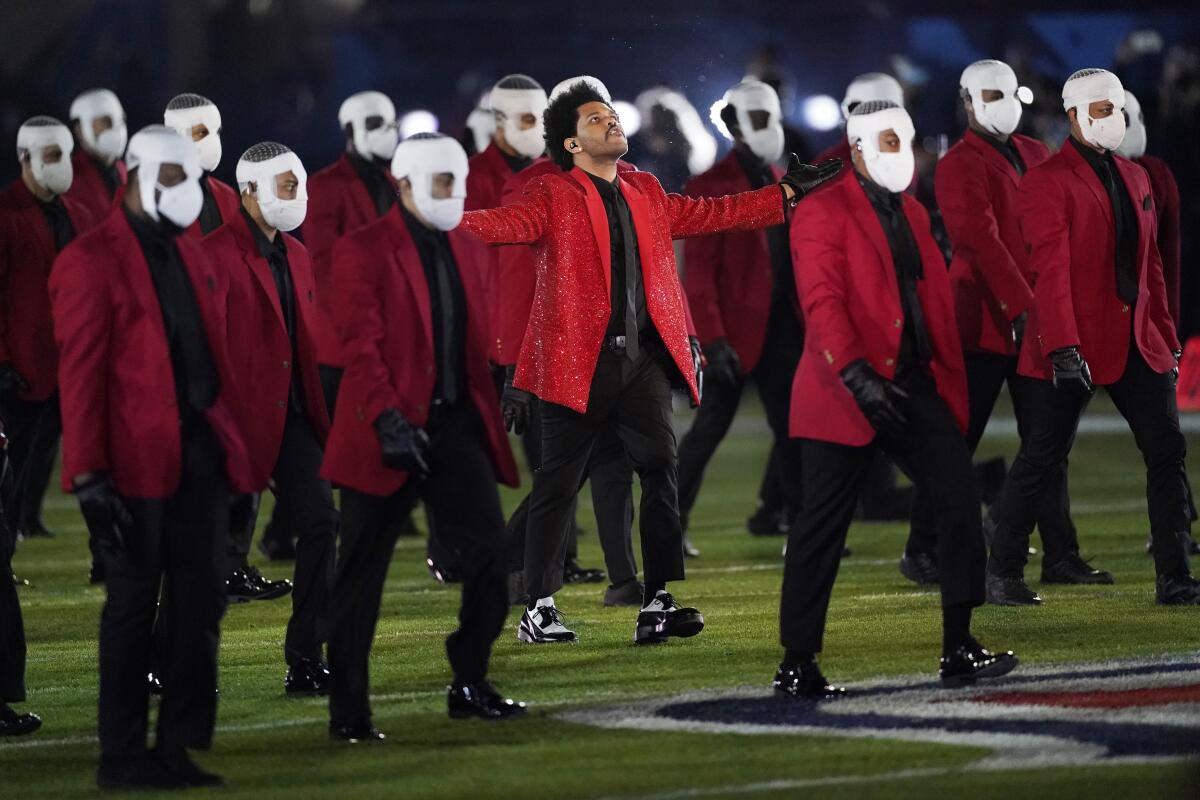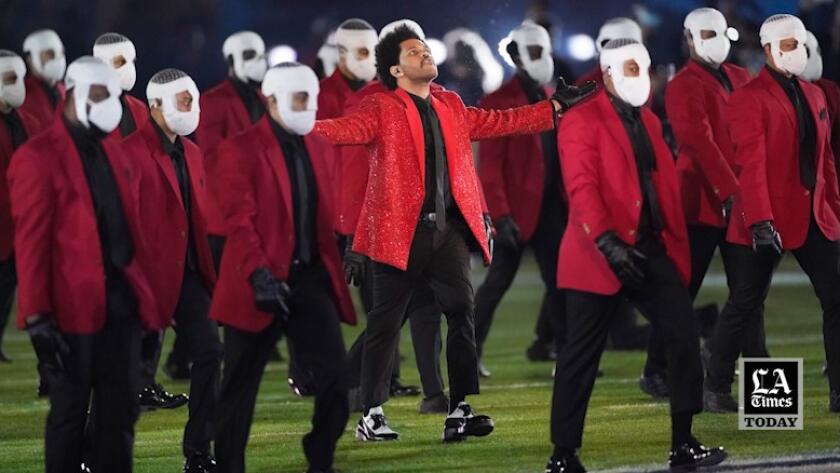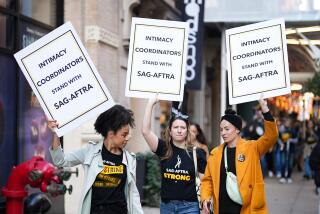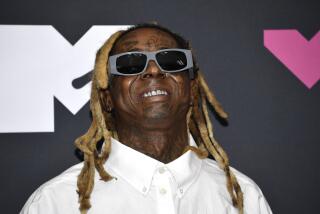Unpaid dancers say they worked side by side with paid dancers in 2021 Super Bowl halftime show

- Share via
A red suit coat and a hat. That’s what some dancers were paid for more than 60 hours of work over a period of 10 days as part of the “field cast” during last year’s Super Bowl LV halftime show featuring the Weeknd.
In a recent interview with The Times, dancer and choreographer Kahdre Walker recalled his experience as an unpaid volunteer in the 2021 show. Toward the end of the performance at Raymond James Stadium in Tampa, Fla., Walker says that paid dancers joined the unpaid dancers on the field, surrounding the Weeknd as he sang. Everybody on the field was dancing, wearing the same uniform of a red suit coat and white bandage face mask. Unpaid dancers were taught choreography by professional choreographer Charm La’Donna, Walker says.
The paid dancers, Walker says, were “in front of me, beside me ... Some of them changed their jackets and they blended in with us. We were literally standing next to celebrity dancers,” he says, recalling that he recognized a dancer who had just performed on the Grammys.
Watching the show, viewers were likely unaware that two different groups were at work — and were treated unequally.
Only certain performers received compensation for this union gig, which operated according to SAG-AFTRA rules. For the 2021 Super Bowl halftime show, according to numbers provided in a text by Walker, paid dancers received $712 for show day and $45 per hour for their rehearsal time, as well as a $30 per diem and a $250 COVID stipend if a dancer was asked to report to a clinic for a test on a nonwork day. Unpaid dancers, says Walker, sat in stadium bleachers for up to two hours in the cold while waiting to rehearse as their paid counterparts spent that time in green rooms.
Outrage is rising in the dance community when it comes to the way dance artists and others are treated as unpaid volunteers working on the field during Super Bowl halftime shows, past and present. The issue gained visibility late last week when dance artist and activist Taja Riley posted on Instagram after she learned that a call had gone out to professional dancers to work as volunteers on this year’s Super Bowl halftime show via prominent dance agency Bloc L.A.
Super Bowl LVI’s halftime show choreographer, Fatima Robinson, said in an interview with The Times that the only reason the call was issued by the agency was because she was a Bloc client — and to see if dancers knew others within their networks who would be interested in volunteering on the field. These unpaid volunteers, said Robinson, in a sentiment echoed by a casting manager working as a contractor for halftime show executive producer Roc Nation, needed only to be able to “walk and chew gum at the same time,” and were being recruited through local drill teams as well as theatrical, community and athletic groups, not via professional agencies. Professional, paid dancers, she said, were being hired separately via agencies, and were doing the choreography.
Walker’s experience in last year’s Super Bowl puts that statement into question, as he and other dancers interviewed by The Times say that the situation regarding paid and unpaid labor for dancers performing during the halftime show feels purposely muddied by organizers.
“Their team was very organized, they knew when to give info and not give information. They were very strategic about how to go about things,” says Walker, explaining how organizers first referred to the paid dancers as the “chorus”; he says the field cast initially thought that meant a chorus of singers. Then, Walker adds, the field cast began noticing that the “chorus” was composed of dancers from L.A. and New York, as he puts it: “people we knew from the industry — that I’ve taken classes with — very popular dancers.”
“When we realized the choir was not a choir but actual dancers, they couldn’t say, ‘OK guys, there’s going to be a second cast of dancers coming out,’” he says. “That’s when the language started to change.”
At that point, Walker says organizers began referring to the “chorus” as the “riser cast,” because they were up on the risers before they joined the field cast.
For him, it felt like “we were the very last option of what they were willing to put their money toward.”
Matters were confused further, Walker says, by the fact that some of the field volunteers were not professional dancers and were clearly fans with no dance credentials. “We were going to rehearsal, learning actual choreography, and people were beginning to question not being paid,” he says, noting they then thought maybe they weren’t being paid because there were amateurs on the field with them.
“I think that was protecting them from having to pay us,” adds Walker, who is a ballroom and Latin dance instructor, and who has worked as a choreographer for music videos and commercials.
Devyck Bull, who worked as a paid dancer during the Weeknd’s Super Bowl halftime show, tells The Times that the paid dancers didn’t know what was going on at first.
“We had no idea that people were doing the same thing as us but not getting paid,” Bull says. “We thought they were nondancers. We had no idea that other professional dancers were asked to do professional work until after, when we found out that definitely more than half the people there were doing free work.”
Bull says that the unpaid dancers began talking with the paid dancers, and many of them were completely unaware that anybody was getting paid, or that they could use the experience as one of the three union gigs required to gain membership to SAG-AFTRA. Walker, who is not a union member, falls into the latter category, and recently filed a claim with SAG-AFTRA for the work he did on the show in 2021.
Riley, the dance artist and choreographer who initially posted the call for reform on Instagram, says this lack of information and transparency falls squarely at SAG-AFTRA’s feet.
“My problem with SAG-AFTRA is their lateness and lack of attention to detail,” says Riley, adding that she contacted the union about the situation and a representative told her the union had no idea that professional dancers were working as unpaid volunteers during Super Bowl halftime shows.
A representative for SAG-AFTRA said that once the union was notified that members might be participating as unpaid volunteers, it contacted the production immediately.
“Members/professional performers should never work for free and in some jurisdictions not compensating workers for their labor, even if it is referred to as a ‘volunteer’ role, could be a violation of the law,” the SAG-AFTRA rep wrote in an email. “We will be observing carefully for future Super Bowl halftime shows to make sure it doesn’t happen.”
Bull said that as discontent ramped up during rehearsals at the Weeknd’s halftime show, the paid dancers realized no SAG-AFTRA rep was on-site, so they asked for one.
The rep eventually came, says Bull, but only a few days before the actual show.
“By the time they got there, it was too late to put action into knowing that over 100 dancers were not being paid,” says Bull.
On Tuesday evening, SAG-AFTRA issued a statement to The Times that said, “SAG-AFTRA and the producers of the Super Bowl Halftime Show have met and had an open and frank discussion, and have agreed that no professional dancers will be asked to work for free as part of the halftime show. SAG-AFTRA will be advising our professional dancer members that they should not be rehearsing or working on the Super Bowl halftime show without compensation.”
The statement concluded, “We are grateful to Roc Nation, their producer and in particular our member Jay-Z, for their collaboration and commitment to professional artists. As a union, we believe all working participants should be paid and compensated for their labor.”
Riley says that the statement dodges the main issue: that any and all people, dancers or not, working to add value to a Super Bowl halftime show should be paid for their labor. She says that as long as payment is withheld from field cast participants, dancers will continue to be preyed upon by opportunistic producers. The lure of exposure is just that powerful in the competitive industry, she says.
Walker remembers thinking at the time, “‘This is my opportunity’ — this was my big once-in-a- lifetime opportunity to put this on my résumé, and I didn’t want to mess it up.”
So he stayed quiet, despite his misgivings.
“Nobody was talking about it when it was my time,” he says. “But people are talking about it now.”
- Share via
Watch L.A. Times Today at 7 p.m. on Spectrum News 1 on Channel 1 or live stream on the Spectrum News App. Palos Verdes Peninsula and Orange County viewers can watch on Cox Systems on channel 99.
More to Read
The biggest entertainment stories
Get our big stories about Hollywood, film, television, music, arts, culture and more right in your inbox as soon as they publish.
You may occasionally receive promotional content from the Los Angeles Times.












